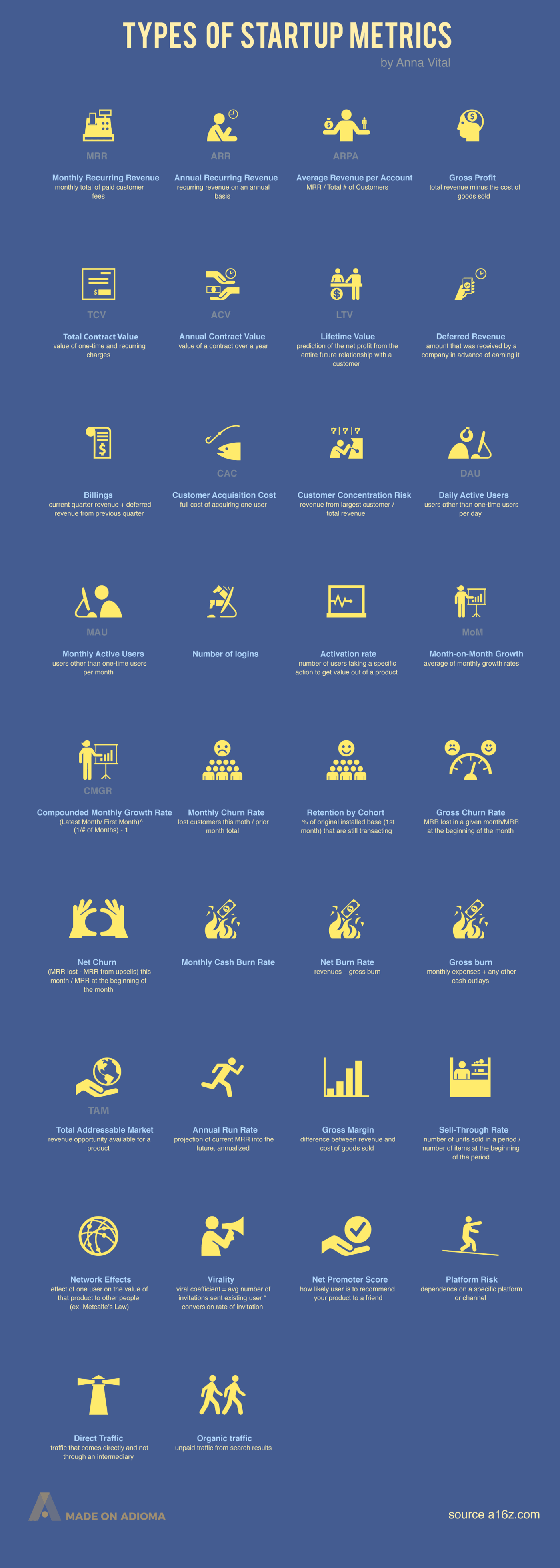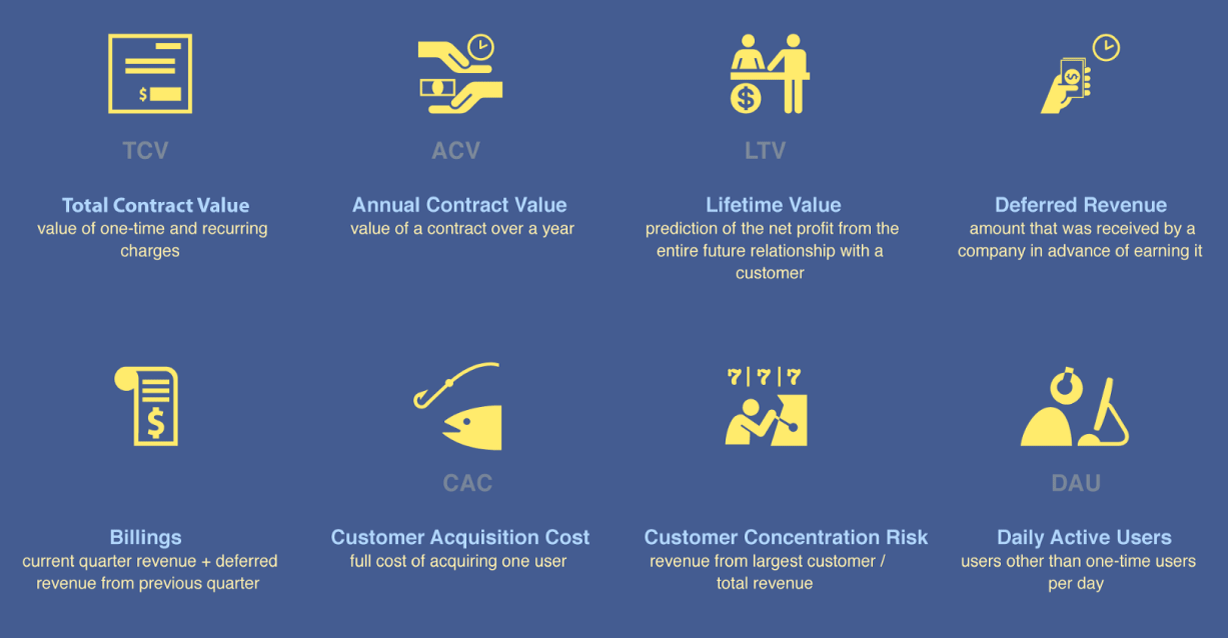Technology
34 Startup Metrics for Tech Entrepreneurs

Courtesy of: Funders and Founders
34 Startup Metrics That Tech Entrepreneurs Need to Know
Today’s infographic comes from Funders and Founders and information designer Anna Vital, and it lists the important metrics to gauge traction and success of new startups.
Several years ago, a key challenge with launching a new tech startup venture was that there weren’t many precedents to follow.
- How do you scale a company?
- How do you measure growth and costs in a more meaningful way?
- Does the company have real traction?
Of course, there were knowledgeable people in the tech ecosystem that knew these things – for example, venture capitalists and ex-founders that had been successful with previous ventures – but they were tough to gain access to, and many of their theories and best practices weren’t yet widespread.
Fast forward to today, and the practices around new startups are much more established. While this can be a blessing and a curse to new founders, at least a more standardized set of metrics helps to give founders a sense of where their company stands.
Key Startup Metrics, According to VCs
The infographic from Funders and Founders lists 34 startup metrics for founders to know – but which one should be a focus for new ventures?
Here’s what three bigtime VCs have said about the startup metrics that they consider to be most important at early stages:
“Month-over-Month Organic Growth”
For most companies, MoM organic growth is a very useful metric and depending on the base, 20–50% MoM growth can be good. Retention, referral, and churn are all things we look at, too.
– Aileen Lee, Cowboy Ventures
According to Aileen Lee, who originally came up with the “unicorn” term, organic growth is a particularly useful metric.
On the other hand, Bill Gurley of Benchmark says that monitoring conversions is a comprehensive metric that is a good proxy for several key business areas.
“Conversion Rate”
No other metric so holistically captures as many critical aspects of a web site – user design, usability, performance, convenience, ad effectiveness, net promoter score, customer satisfaction – all in a single measurement.
– Bill Gurley, Benchmark
Paul Graham, of Y Combinator fame, says that the metric depends on the stage. If you have revenue, then revenue growth is the metric you want. If you’re not there yet, user growth is a good proxy.
“Revenue Growth or Active Users”
The best thing to measure the growth rate of is revenue. The next best, for startups that aren’t charging initially, is active users. That’s a reasonable proxy for revenue growth because whenever the startup does start trying to make money, their revenues will probably be a constant multiple of active users.
– Paul Graham, VC and co-founder of Y Combinator
It should also be noted that the most relevant metric to you depends on your business model. For example, MRR (Monthly recurring revenue) and churn rates would be particularly important to SaaS (Software-as-a-service) startups, while MAUs (Monthly active users) and organic traffic may be more important measurements for online media companies.
Technology
Visualizing AI Patents by Country
See which countries have been granted the most AI patents each year, from 2012 to 2022.

Visualizing AI Patents by Country
This was originally posted on our Voronoi app. Download the app for free on iOS or Android and discover incredible data-driven charts from a variety of trusted sources.
This infographic shows the number of AI-related patents granted each year from 2010 to 2022 (latest data available). These figures come from the Center for Security and Emerging Technology (CSET), accessed via Stanford University’s 2024 AI Index Report.
From this data, we can see that China first overtook the U.S. in 2013. Since then, the country has seen enormous growth in the number of AI patents granted each year.
| Year | China | EU and UK | U.S. | RoW | Global Total |
|---|---|---|---|---|---|
| 2010 | 307 | 137 | 984 | 571 | 1,999 |
| 2011 | 516 | 129 | 980 | 581 | 2,206 |
| 2012 | 926 | 112 | 950 | 660 | 2,648 |
| 2013 | 1,035 | 91 | 970 | 627 | 2,723 |
| 2014 | 1,278 | 97 | 1,078 | 667 | 3,120 |
| 2015 | 1,721 | 110 | 1,135 | 539 | 3,505 |
| 2016 | 1,621 | 128 | 1,298 | 714 | 3,761 |
| 2017 | 2,428 | 144 | 1,489 | 1,075 | 5,136 |
| 2018 | 4,741 | 155 | 1,674 | 1,574 | 8,144 |
| 2019 | 9,530 | 322 | 3,211 | 2,720 | 15,783 |
| 2020 | 13,071 | 406 | 5,441 | 4,455 | 23,373 |
| 2021 | 21,907 | 623 | 8,219 | 7,519 | 38,268 |
| 2022 | 35,315 | 1,173 | 12,077 | 13,699 | 62,264 |
In 2022, China was granted more patents than every other country combined.
While this suggests that the country is very active in researching the field of artificial intelligence, it doesn’t necessarily mean that China is the farthest in terms of capability.
Key Facts About AI Patents
According to CSET, AI patents relate to mathematical relationships and algorithms, which are considered abstract ideas under patent law. They can also have different meaning, depending on where they are filed.
In the U.S., AI patenting is concentrated amongst large companies including IBM, Microsoft, and Google. On the other hand, AI patenting in China is more distributed across government organizations, universities, and tech firms (e.g. Tencent).
In terms of focus area, China’s patents are typically related to computer vision, a field of AI that enables computers and systems to interpret visual data and inputs. Meanwhile America’s efforts are more evenly distributed across research fields.
Learn More About AI From Visual Capitalist
If you want to see more data visualizations on artificial intelligence, check out this graphic that shows which job departments will be impacted by AI the most.
-

 Markets1 week ago
Markets1 week agoU.S. Debt Interest Payments Reach $1 Trillion
-

 Business2 weeks ago
Business2 weeks agoCharted: Big Four Market Share by S&P 500 Audits
-

 Real Estate2 weeks ago
Real Estate2 weeks agoRanked: The Most Valuable Housing Markets in America
-

 Money2 weeks ago
Money2 weeks agoWhich States Have the Highest Minimum Wage in America?
-

 AI2 weeks ago
AI2 weeks agoRanked: Semiconductor Companies by Industry Revenue Share
-

 Markets2 weeks ago
Markets2 weeks agoRanked: The World’s Top Flight Routes, by Revenue
-

 Demographics2 weeks ago
Demographics2 weeks agoPopulation Projections: The World’s 6 Largest Countries in 2075
-

 Markets2 weeks ago
Markets2 weeks agoThe Top 10 States by Real GDP Growth in 2023















